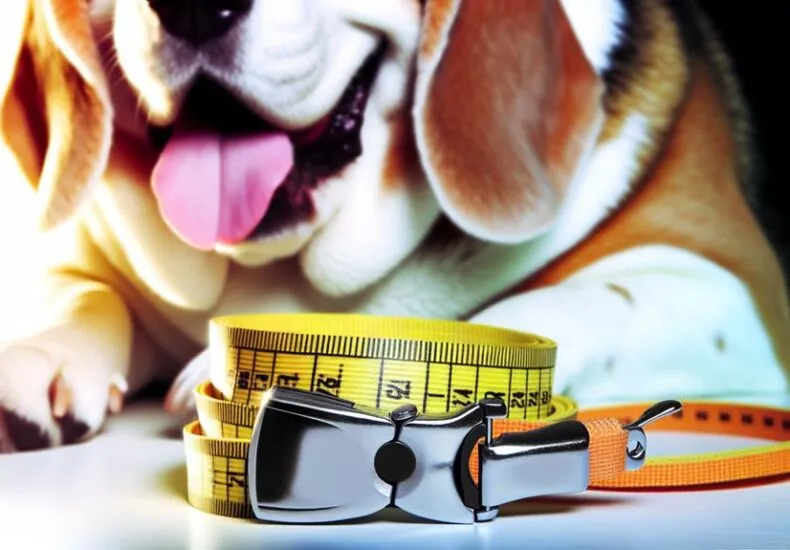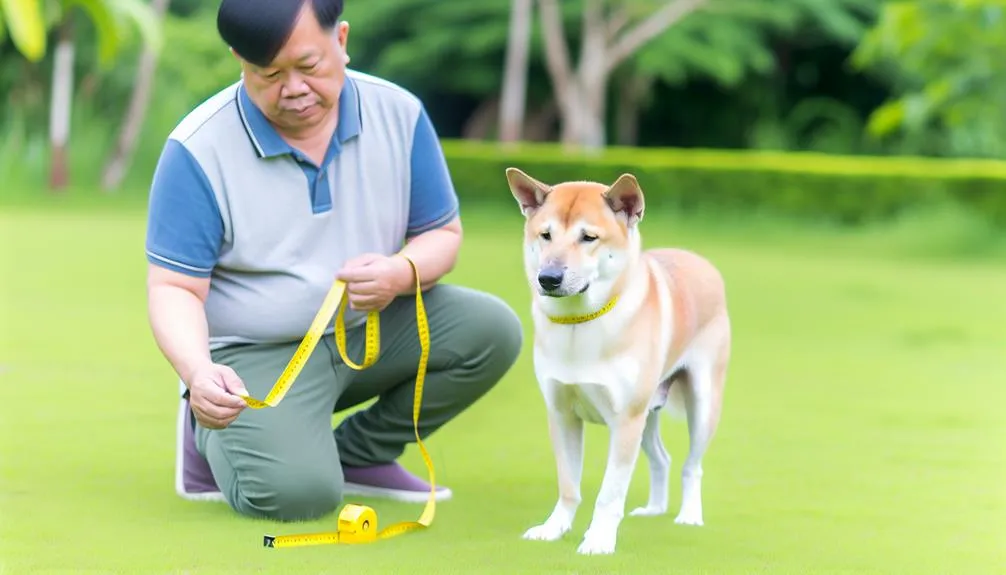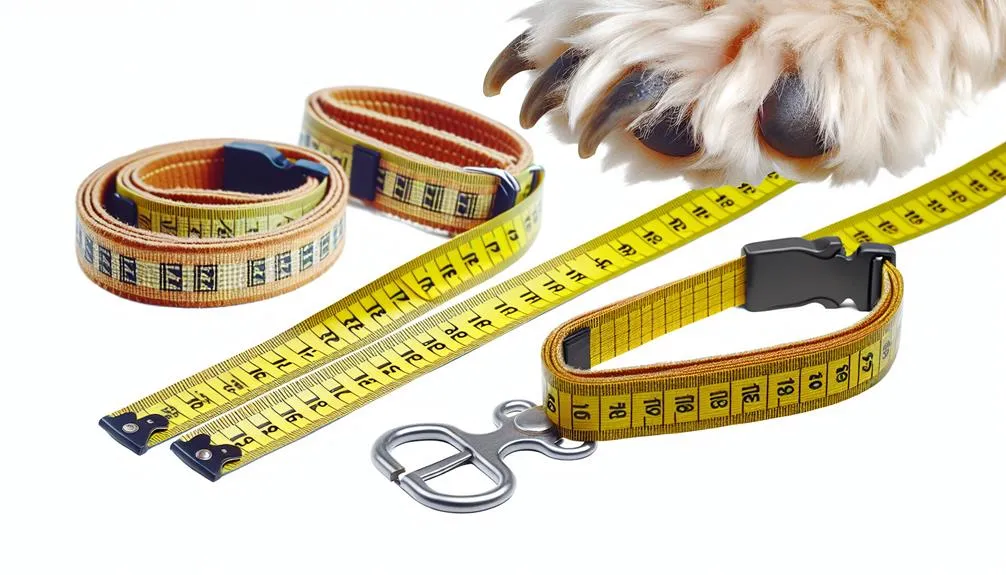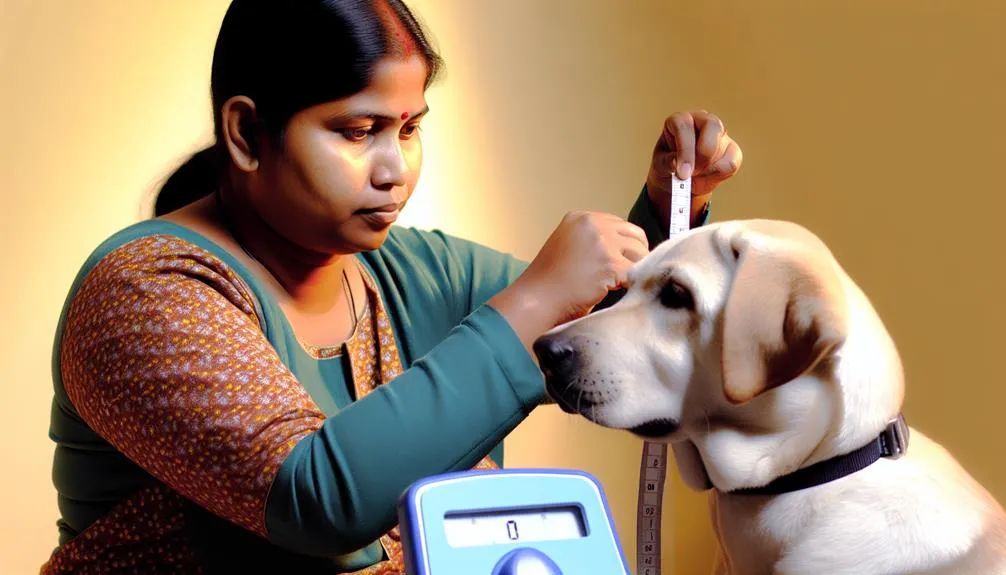
How to Measure No Pull Dog Collar Size
When it comes to selecting the right size for a no-pull dog collar, you need to start by measuring your dog's neck accurately. You'll want to use a flexible measuring tape to get the circumference at the base of the neck, ensuring your dog is calm and comfortable. It's important to make sure the tape is snug but not too tight—two fingers should fit underneath. However, that's just the beginning. There are other factors to take into account that can greatly affect the collar's effectiveness and comfort. Let's explore those vital details.
Understanding Collar Types
When choosing a dog collar, it is essential to understand the different types available. Each collar type serves a specific purpose and can greatly affect your dog's comfort and training success. The most common types are flat collars, martingale collars, and harnesses, each made from various collar materials like nylon, leather, and fabric.
Flat collars are the most standard option, perfect for everyday use. They come in various styles and colors, but they don't provide much control during training. Martingale collars, on the other hand, offer a gentle tightening mechanism that prevents dogs from slipping out. They're ideal for training because they provide a balance between comfort and control without choking the dog.
Harnesses distribute pressure across your dog's body, making them a great choice for dogs that pull on the leash. They come in front-clip and back-clip designs, each offering unique training benefits. Front-clip harnesses can help redirect your dog's attention, while back-clip harnesses are easier to put on and take off.
Consider the collar materials when selecting a collar type; durable materials like nylon and leather can withstand wear and tear, ensuring longevity. Ultimately, the right collar can enhance your dog's training experience and promote positive behavior. By understanding the various collar types and their benefits, you can make an informed choice that meets your dog's needs and supports your training goals.
Gathering Your Measuring Tools
Before you start measuring your dog's collar size, it's important to gather the right tools to confirm accuracy. Having the proper measuring tools on hand will guarantee you get the perfect fit for your dog's no-pull collar. First, you'll need a flexible measuring tape, which is ideal for wrapping around your dog's neck. If you don't have one, a piece of string can work in a pinch; you can measure the string against a ruler later.
Next, think about having a pen and paper ready to jot down your measurements. This way, you won't forget the numbers and can refer back to them when selecting the collar. It's also helpful to have a friend around to assist you, especially if your dog tends to move around a lot during the measuring process.
When measuring, it's important to use proper measuring techniques. Make sure the tape is snug but not too tight; you should be able to fit two fingers comfortably between the tape and your dog's neck. This will ensure the collar is comfortable without being restrictive.
Lastly, keep in mind the collar materials you'll want to take into account—different materials may require slight adjustments in sizing due to their flexibility or thickness. By gathering these tools and being mindful of your techniques, you'll be well on your way to finding the right collar size for your furry friend.
Preparing Your Dog for Measurement

How can you ascertain your dog is calm and ready for measurement? Preparing your dog for this process is vital to guarantee accurate measurements. Start by creating a peaceful environment. Choose a quiet space free from distractions, like loud noises or other pets, that could affect your dog's behavior.
Next, engage in some light training tips to help your dog relax. Spend a few minutes practicing basic commands, such as sit or stay. This not only reinforces good behavior but also helps establish a calm mindset. If your dog tends to be anxious, consider using calming aids like a favorite toy or treat to create a positive association with the measuring process.
Timing is also important. Try to measure your dog when they're naturally calm, perhaps after a walk or play session. Avoid attempting to measure when they're overly excited or energetic, as this can lead to fidgeting and inaccurate results.
Additionally, maintain a gentle and positive approach. Speak softly to your dog throughout the process, reassuring them that everything's okay. If your dog feels secure and loved, their behavior will likely improve, making the measurement easier.
Lastly, practice patience. If your dog seems restless or uneasy, take a break and try again later. Taking the time to prepare your dog properly will not only result in more accurate measurements but also strengthen the bond between you and your furry friend.
Measuring Neck Circumference
To accurately measure your dog's neck circumference, you'll want to use a flexible measuring tape for precision. Start by confirming your dog is calm and standing comfortably. Wrap the measuring tape around the base of your dog's neck, where the collar normally sits. It's important to make certain the tape is snug but not too tight; you should be able to fit two fingers underneath it. This guarantees both comfort and security when you select the collar material.
Different dog breeds can have varying neck shapes, so pay attention to how the tape sits against your dog's fur. For instance, a Bulldog might have a thicker neck compared to a Greyhound, which requires a different approach to measuring. If your dog has a thick coat, you may want to press the tape against the skin for a more accurate measurement.
Once you've taken the measurement, double-check it to verify accuracy. If your dog is between sizes, it's often best to opt for the larger size, especially if you're pondering a no-pull collar. The collar material can affect how it fits, so keep in mind that some materials may stretch slightly over time. Write down the measurement, and remember to reflect on the collar's adjustment range as you shop. Getting the right neck circumference is essential for your dog's comfort and safety.
Accounting for Collar Width

When choosing a collar for your dog, the width is just as important as the neck circumference. A wider collar can provide better support and distribute pressure more evenly, while a narrower one may be more comfortable for smaller breeds. Understanding how to measure collar width will help you find the best fit for your furry friend.
Importance of Collar Width
Many dog owners overlook the importance of collar width, but it plays a crucial role in your pet's comfort and safety. The right width can distribute pressure more evenly across your dog's neck, reducing the risk of injury or discomfort, especially during pulling. Wider collars often provide better control and stability.
When selecting a collar, you should also consider the materials used. For instance, softer fabric collars can enhance dog comfort, whereas wider nylon collars may be more durable but could cause irritation if not fitted properly. Here's a quick guide to help you understand the ideal collar width based on your dog's size:
| Dog Size | Recommended Width | Collar Materials |
|---|---|---|
| Small Breeds | 1/2 inch | Soft nylon/fabric |
| Medium Breeds | 3/4 inch | Durable nylon/leather |
| Large Breeds | 1 inch | Heavy-duty nylon |
Measuring Techniques Explained
Selecting the right collar width is just the start; accurately measuring your dog's neck is essential for a perfect fit. To do this, grab a flexible measuring tape or a piece of string. If you're using string, mark where it overlaps, then measure that length against a ruler. Wrap the tape snugly around your dog's neck, just below the collar line. Make certain it's not too tight; you should be able to fit two fingers underneath for ideal dog comfort.
Once you have the measurement, consider the collar materials. Different materials can affect how the collar fits and feels on your dog. For instance, nylon collars tend to be thinner and may require a slightly tighter fit, while leather collars are often bulkier, needing a bit more room.
When you've determined the right size, confirm the collar is adjustable to account for any growth or changes in your dog's coat. Also, remember that a well-fitted collar not only enhances comfort but also reduces the risk of chafing or irritation, making walks more enjoyable for both you and your furry friend.
Choosing the Right Adjustability
When it comes to dog collars, proper fit is essential for your pet's comfort and safety. Adjustable features allow you to customize the collar to your dog's size and growth, ensuring it won't be too tight or too loose. Understanding these options can help you make an informed choice that meets your dog's needs.
Importance of Proper Fit
A proper fit is essential for your dog's collar, as it directly impacts their comfort and safety. When you choose a collar that fits correctly, you'll enjoy the benefits of comfort for your dog, which can lead to better behavior and a more enjoyable walking experience. A collar that's too tight can cause discomfort and even injuries, while one that's too loose might slip off or become ineffective.
Here's a quick overview of what to evaluate for proper fit:
| Collar Size | Benefits of Comfort | Preventing Injuries |
|---|---|---|
| Small | Allows freedom of movement | Reduces chafing |
| Medium | Supports better training | Minimizes strain |
| Large | Enhances relaxation | Protects against escapes |
Adjustable Features Explained
Finding the right collar size is just the beginning; understanding adjustable features can make all the difference in achieving a perfect fit. When looking for a no-pull dog collar, consider the adjustable mechanisms available. These features allow you to customize the collar's size, guaranteeing it fits snugly without being too tight. An adjustable collar can accommodate your dog's growth or changes in their coat, providing versatility over time.
Pay attention to how the collar adjusts. Some collars use slide adjusters, while others incorporate buckles or clips. Each type has its own advantages, but ease of use and reliability are key for collar safety. You want something that won't slip or come undone during walks.
Additionally, check for multiple adjustment points. Collars with more than one adjustable area can offer a more personalized fit, enhancing comfort for your furry friend. Remember, a well-adjusted collar not only improves your dog's comfort but also contributes to their safety. If the collar's too loose, it can slip off; if it's too tight, it can cause choking. Prioritize these adjustable features to guarantee a secure and enjoyable experience for both you and your dog.
Testing the Collar Fit

Typically, testing the collar fit involves checking for both comfort and security to confirm your dog can wear it without any issues. An ill-fitting collar can lead to discomfort or even escape, which can be stressful for you and your pet. To ascertain the collar is suitable, consider the materials used in its construction. Different collar materials can affect your dog's behavior and how they react during walks.
Start by placing the collar around your dog's neck and adjusting it so it fits snugly but allows for two fingers to slide between the collar and your dog's neck. This guarantees it's not too tight, which might cause discomfort, or too loose, which can lead to slipping off.
Here's a quick reference table to help you assess the fit:
| Feature | Ideal Fit | Signs of Poor Fit |
|---|---|---|
| Comfort | Two fingers can fit beneath collar | Dog scratches or tries to remove |
| Security | Snug without choking | Easily slides off |
| Material Quality | Soft, durable, and breathable | Rough texture or breaks easily |
Pay attention to how your dog behaves while wearing the collar. If they seem anxious or excessively paw at it, it might not be the right fit or material for them. Ultimately, a well-fitted collar not only enhances your dog's comfort but also encourages better behavior during walks, making outings enjoyable for both of you.
Frequently Asked Questions
Can I Use a Regular Tape Measure for Measuring My Dog's Neck?
Yes, you can use a regular tape measure for your dog's neck. When choosing collar types, make sure to apply accurate measuring techniques, ensuring a comfortable fit that prevents pulling and irritation for your furry friend.
How Tight Should the Collar Be When Measuring?
When measuring for collar tightness, you should aim for a snug fit—enough to fit two fingers between the collar and your dog's neck. This measuring technique guarantees comfort while preventing slippage or choking hazards.
What if My Dog Has a Thick Fur Coat?
If your dog's got a thick fur coat, like a Golden Retriever, consider fur type considerations. Use collar fitting techniques like measuring the neck over the fur, ensuring it's snug but comfortable for your pup.
Is It Necessary to Measure Both Neck and Head?
You should measure both head circumference and neck size. Different collar types require precise measurements to guarantee proper fit. A collar that's too tight or loose can lead to discomfort or escape risks for your dog.
How Often Should I Re-Measure My Dog for Collar Size?
You should re-measure your dog's collar size every few months, especially during growth stages. Regular collar adjustment frequency guarantees a comfortable fit, preventing any discomfort or safety issues as your dog matures.
Conclusion
Once you've measured your dog's neck and chosen the right collar, take a moment to imagine your next walk together. Will you both feel that sense of freedom and connection, or will discomfort hold you back? By ensuring the perfect fit, you can open up a world of joyful exploration, where every step is a proof of trust and control. Don't underestimate the impact of a well-fitted collar—your adventures await, just a snug adjustment away.
You may also like
Archives
Calendar
| M | T | W | T | F | S | S |
|---|---|---|---|---|---|---|
| 1 | 2 | 3 | 4 | 5 | 6 | |
| 7 | 8 | 9 | 10 | 11 | 12 | 13 |
| 14 | 15 | 16 | 17 | 18 | 19 | 20 |
| 21 | 22 | 23 | 24 | 25 | 26 | 27 |
| 28 | 29 | 30 | ||||
Leave a Reply